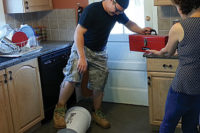The first step in caring for and maintaining a natural stone floor is to identify the type of floor. There are many different types of natural stone. Among the most popular are granite, marble, limestone and sandstone. Next, it is important to determine if the floor has been newly installed or if it is an older floor. Once the type of stone floor and time of installation has been identified, it will be relatively easy to provide a proper maintenance program for your client.
For new natural stone floors, the care and maintenance begin immediately after installation. During the installation of a new floor, the mortar used to set the floor frequently overflows through the joints, creating cement-based remnants. These dried remnants should be removed using an acid-based cleaner. However, many acids can cause damage and discoloration to stone. Only acid-based cleaners specifically designed for use on natural stone are recommended. Cleaners not specifically indicated for cleaning natural stone may cause a yellowish discoloration to the stone and can dispense an aggressive steam. This steam can damage mirrors, metal lampshades and banisters. Also, when dealing with marble, cleaners that are alkaline-based should be used, as acids may etch the stone.
Application of the cleaning product is simple if a few basic rules are considered. As with any new cleaning product or procedure, always test the product in a small and inconspicuous place before cleaning an entire surface. Use the test patch to determine the product's effectiveness, as well as the dilution ratio of the new cleaner. Prior to cleaning, coat the floor with water and let stand for 10 minutes. Next, remove the water with a squeegee. This procedure of coating the floor with water prior to the application of the cleaning product allows the capillaries of the stone to absorb the water molecules. The absorption of the water molecules, due to their large size in comparison to those of the acid-based cleaner, prevents the acid from penetrating the stone too deeply. Next, apply the cleaner in the proper dilution ratio to the surface of the floor and vigorously agitate with a brush. After a few minutes, remove the cleaning solution using a wet vacuum. The floor should be completely free of mortar. The last step in the cleaning process is to neutralize the floor. The floor should be neutralized using an alkaline-based stone cleaner diluted with clean water. Apply the product to the floor with a clean mop and remove with a wet vacuum. This will reduce and then eliminate any acid residue remaining on the floor. Repeat this last step if necessary until all remaining cleaning agents are totally removed. Polishing of a new floor can be delayed until it is necessary to restore the floor's luster.
Proper care of an existing floor is essential in restoring and maintaining the stone's natural beauty. Because the existing wax present on the floor may not be appropriate for the type of stone flooring (i.e. a generic floor finish on natural stone), the first recommended step is to strip the floor. A basic stripping procedure is recommended using a wax stripper designed specifically for the type of natural stone being cleaned, a 175-rpm floor polishing machine with a white pad (on granite, use a dark pad), and a wet vacuum. The wax stripper should be applied and allowed to sit for 10 minutes. Next, use the polishing machine to work the area where the stripper was applied until the wax is removed. The area is then washed using clean water and a wet vacuum. Repeat the process if necessary, and let the area dry for 12 hours -- depending on the type of stone. (i.e. two days are recommended for sandstone) -- before applying protection treatment.
After stripping a floor, it is often recommended to protect the stone by applying an impregnator. The proper impregnator will penetrate the stone capillaries, protecting the stone from oil, dirt and water. These impregnators usually do not change the surface texture of the stone, and the stone's color should remain unchanged. However, if an enhanced color is desired, a color intensifier can be applied. Special impregnators designed for natural stone not only protect the stone, but also enable it to breathe, allowing vapors to escape. Enabling the stone to breathe is critical to the proper maintenance of any natural stone. Sealers may trap moisture within the stone, rendering it susceptible to mold and mildew. Eventually, this may lead to a breakdown of that stone.
The final step to a beautiful looking floor is the application of a wax specifically designed for natural stone. Again, a basic waxing procedure is recommended using a polishing machine (175 rpm) with a white polishing pad and a quality stone polish. The polish is applied evenly to the floor and allowed to dry to a haze. The area is then buffed with a polishing machine. Repeat the process if necessary until the desired luster is achieved. While polishing is recommended to restore the original beauty of the natural stone, some floors may require mechanical grinding in order to restore the stone to its original state. In this case, it is recommended to consult a professional.
Once the natural beauty has been restored, the daily maintenance is simple. The top enemy to a natural stone floor is sand and dirt. Heavy foot traffic can abrade the natural polish of the stone. It is essential to have a dust-mopping program scheduled for multiple times per day in high-traffic areas. Based on traffic volume, stone soap should be applied daily, weekly or bi-weekly. The product should be allowed to dry to a haze and buffed. When the floor begins to wear, the process is repeated.
It is important to remember that when working with any type of chemicals, proper protective equipment should be donned. In addition, when working on all types of floors that create a slip hazard, caution signs should be properly placed.
Proper care of natural stone floors involve simple procedures that can be instituted into a basic maintenance schedule. If instituted properly, this maintenance schedule will ensure that the natural stone is properly cleaned and cared for. The expected result of a brilliant, lustrous stone floor will most certainly be achieved.




